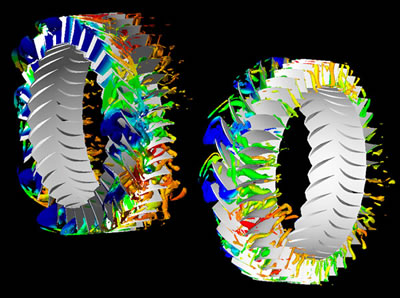Stage of an Axial-Flow Compressor during Rotating Stall
In aeronautics, the most widespread propulsion system is the jet engine. The weight of the motor, its fuel consumption and the thrust available for the aircraft are partly determined by the compressor's ability to give the fluid the maximum of energy per compression stage.

copyright © ONERA 1996-2006 - All rights reserved
Vizualization of the 3D structures,
colored according to pressure,
in a stage of an axial-flow compressor
during rotating stall
(elsA calculation)
DAAP
In order to reduce the compressor weight, and hence the weight of the complete engine, motorists seek to reduce the number of stages within the compressor. In this case, it is necessary to increase the quantity of energy given to the fluid by each stage of the compression system. The main problem is that close to the maximum pressure rate, aerodynamic instabilities appear (surge and rotating stall) and can destroy the compressor.
Onera is currently involved in a study to understand the structure and origins of unstable flows thanks to numerical simulation. The picture above is the result of an unsteady Navier-Stokes simulation in a complete axial compressor stage during rotating stall. Today, this kind of simulation remains very costly in computer resources (4000 CPU hours with a supercomputer NEC-SX6), yet it makes it possible to calculate precisely the stability limit of the system. Future systems might be able to delay, or even suppress, these flow phenomena and to design lighter and less pollutant machine.
Author : Nicolas Gourdain,
phD student at the Applied Aerodynamics Department